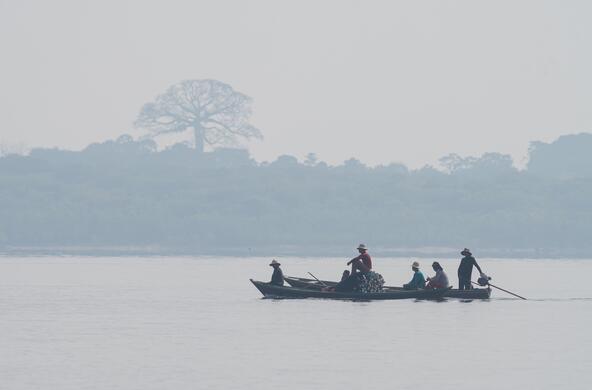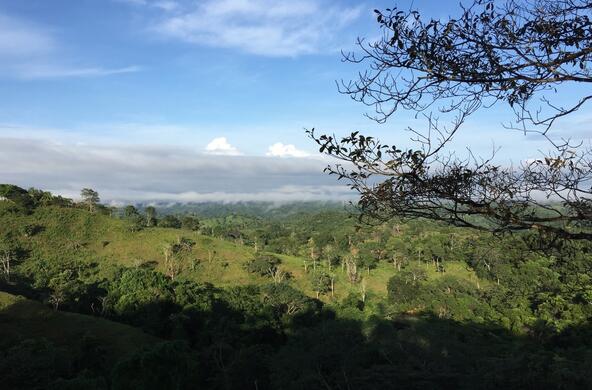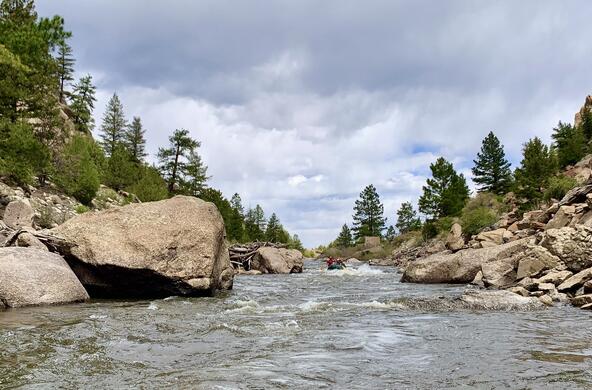As the planetary thermostat climbs, many species in North America are gradually moving northward to cooler climates. However, a new study finds that climate change is pushing at least one bird species in the opposite direction.
American redstarts are born in forests as far north as the Upper Midwest, Upper New England, and Ontario. They spend their winters in the Caribbean before returning to their birthplaces to breed.
The new study, published this week in Proceedings of the National Academy of Science, finds that a long-term drying trend throughout the Caribbean is making it harder for the redstart to survive the return trip to the northernmost parts of its range. With less rain at the overwintering sites, the warblers find it difficult to forage enough insects to fuel their 2,000-or-so-mile journey home. As a result, redstart breeding sites have shifted southward by more than 310 miles since 1990.
Led by Bryant Dossman at Georgetown University, the researchers pulled together several different data sets to make this surprising discovery. Among them was a model that Cary Institute disease ecologist Shannon LaDeau created 15 years ago while working as a postdoctoral researcher at the Smithsonian Migratory Bird Center.
When LaDeau first created the model back in 2005, it was to investigate a question that had nothing to do with redstart migration. Instead, she was trying to see what effect West Nile virus might be having on wild bird populations. While the virus’s effects were readily apparent in urban areas, where birds were found dead along streets, there was less data on what was happening in rural areas.
To overcome this scarcity of data, LaDeau and her colleagues turned to the North American Breeding Bird Survey. Once a year since 1966, volunteers go out and census the number and types of birds they can see or hear along roadsides across the contiguous United States.
“It’s a really important dataset for understanding North American birds,” says LaDeau. “So our idea was that we could look at that data and see if, when West Nile virus was first discovered in different counties, did birds experience population declines? And if so, which ones?”
LaDeau’s model helped to control for factors like missing data and the variable bird-spotting skills of different volunteers, in order to isolate the trend in the data that might be explained by West Nile virus. The technique, called Bayesian hierarchical regression, was relatively novel at the time, but has since become an important tool for ecologists to account for uncertainty and make inferences at multiple scales.
The model identified seven bird species whose populations dropped significantly after West Nile virus arrived on the scene. American crows were hit particularly hard, with abundance dropping by up to 45% between 1998 and 2005. Blue jays, American robins, eastern bluebirds, chickadees, tufted titmouses, and house wrens were also impacted. The team published their findings in Nature in 2007.

Around the same time LaDeau was completing the West Nile research, Colin Studds — who shared the same advisor as LaDeau, Peter Marra — was studying the effects of drought on the American redstart, and realized that LaDeau’s regression might come in handy.
The bulk of Studds’ data comes from a long-term study (1990-2019) that estimated survival rates by capturing the birds in Jamaica, marking them with bands, and then counting how many showed up again the following year. He also collected tail feathers, whose isotope ratios record the latitude at which each bird had spent the breeding season.
LaDeau had a chance to participate in the Jamaica field work during her postdoc, helping to hang nets between mangrove trees to capture the birds. “The birds fly in and get stuck in the net,” she recalls. “I would help to quickly get it out of the net and put it in a little canvas bag. Then somebody else would take a tail feather and measure its weight, record whether it was marked, age it, sex it and gather other data.”
The results from the field study are strong enough to stand alone, says LaDeau, but “because I was already working with the Breeding Bird Survey data, we decided that we could go a step further and see if the patterns in the breeding region agreed with the data that were being collected in the winter region. The Breeding Bird Survey approach gave us the opportunity to really broaden out the spatial scope of what we were considering.”
“It's basically just a statistical model to isolate the signal of trend — in this case, are American redstarts at that breeding site, or in that latitude, a growing population or a shrinking population?” LaDeau’s analysis independently confirmed what the feather isotope ratios had suggested: that the redstarts’ range was contracting southward over time.
Writing up the results got put on the backburner, though, until Bryant Dossman (a current postdoc in Peter Marra’s lab at Georgetown University) picked it back up again several years later, adding new data and analyses.
By linking conditions at the birds’ wintering site to their survival at breeding sites, the paper uncovers a new mechanism by which climate change can alter species distributions. The implications extend far beyond one species of warbler.
“Climate change is having increasingly severe impacts on many migratory animals,” says Dossman. “The Caribbean, in particular, is experiencing drier and less predictable environmental conditions during the winter months, and this trend is projected to worsen. This is especially concerning given that many migratory songbirds spend their non-breeding seasons in the Caribbean.”
“Historically, we thought of range changes as long-term evolutionary processes,” says LaDeau. “Climate change is speeding things up. This is another piece of evidence showing that climate impacts are being felt today.”
LaDeau’s work has evolved rapidly in recent decades. Her analyses of the Breeding Bird Survey data revealed that warmer winters were linked with higher crow mortality from West Nile — presumably because the virus’s mosquito vectors were more likely to thrive. That finding led LaDeau in a new research direction as she realized the scarcity of data related to mosquito composition, abundance, and distribution in urban areas.
Since then, her work with Baltimore Ecosystem Study has helped to unravel how the built and social environments influence mosquito numbers and the diseases they carry across the urban landscape, paving the way for more effective mosquito control.







